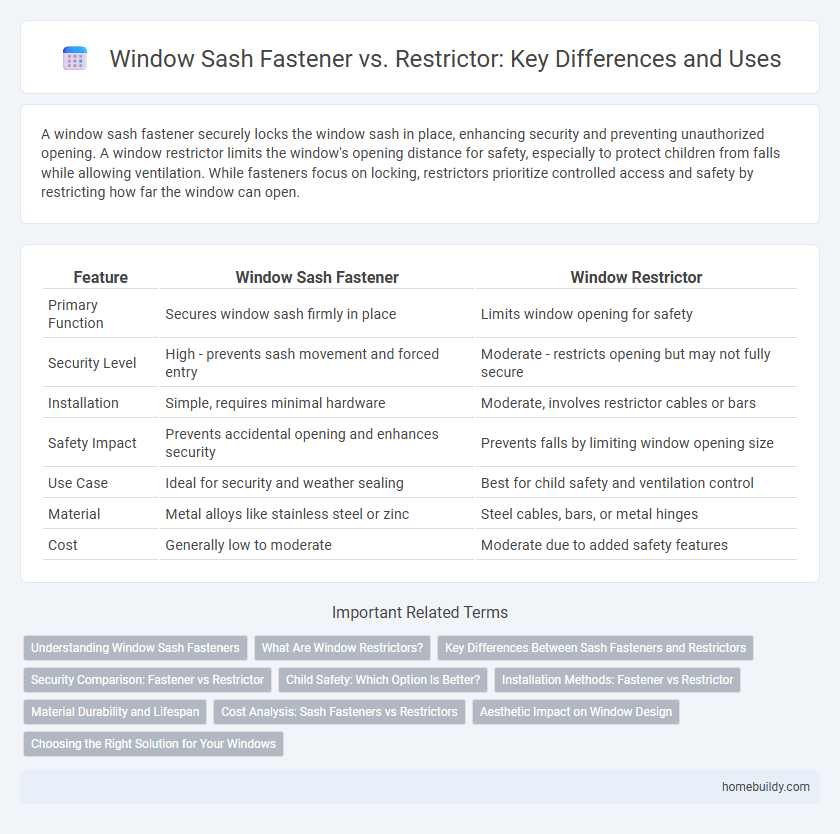A window sash fastener securely locks the window sash in place, enhancing security and preventing unauthorized opening. A window restrictor limits the window's opening distance for safety, especially to protect children from falls while allowing ventilation. While fasteners focus on locking, restrictors prioritize controlled access and safety by restricting how far the window can open.
Table of Comparison
| Feature | Window Sash Fastener | Window Restrictor |
|---|---|---|
| Primary Function | Secures window sash firmly in place | Limits window opening for safety |
| Security Level | High - prevents sash movement and forced entry | Moderate - restricts opening but may not fully secure |
| Installation | Simple, requires minimal hardware | Moderate, involves restrictor cables or bars |
| Safety Impact | Prevents accidental opening and enhances security | Prevents falls by limiting window opening size |
| Use Case | Ideal for security and weather sealing | Best for child safety and ventilation control |
| Material | Metal alloys like stainless steel or zinc | Steel cables, bars, or metal hinges |
| Cost | Generally low to moderate | Moderate due to added safety features |
Understanding Window Sash Fasteners
Window sash fasteners securely hold the window sash in place, providing a tight seal that improves energy efficiency and enhances security. Unlike window restrictors, which limit the window opening for safety purposes, sash fasteners focus on fastening and locking the window firmly shut. Understanding the role of window sash fasteners is essential for maintaining window functionality, weatherproofing, and preventing unauthorized access.
What Are Window Restrictors?
Window restrictors are safety devices installed on window frames to limit the opening distance, reducing the risk of falls while maintaining ventilation. Unlike window sash fasteners, which secure the sash in a closed position for security and weatherproofing, restrictors prevent windows from opening fully, enhancing child and occupant safety. They are essential in homes, schools, and commercial buildings where fall prevention is a priority.
Key Differences Between Sash Fasteners and Restrictors
Window sash fasteners secure the window sash in a closed position, providing airtight sealing and enhanced security by preventing unauthorized opening. Restrictors limit the sash's opening range, allowing ventilation while maintaining safety by reducing the risk of falls or intrusions. Unlike fasteners that lock windows shut, restrictors offer controlled access without complete closure, catering to safety and airflow simultaneously.
Security Comparison: Fastener vs Restrictor
Window sash fasteners provide a robust security solution by tightly locking the window in place, preventing unauthorized opening and enhancing burglary resistance. In contrast, window restrictors limit the sash opening size to allow ventilation while offering moderate security, primarily deterring accidental falls rather than intrusion. Fasteners typically deliver higher security against forced entry, whereas restrictors prioritize safety and controlled access.
Child Safety: Which Option Is Better?
Window sash fasteners provide a secure locking mechanism that prevents windows from being opened fully, significantly reducing the risk of children falling out. In contrast, window restrictors limit the window opening size but may not always offer the same level of robust security against forced openings. For optimal child safety, window sash fasteners are generally considered a better option due to their stronger locking capability and enhanced protection.
Installation Methods: Fastener vs Restrictor
Window sash fasteners typically require drilling into the window frame for secure attachment, ensuring a tight seal and enhanced security against forced entry. In contrast, window restrictors often use either screw-mounted or adhesive installation methods designed to limit sash opening without compromising ventilation or emergency egress. The choice between fastener and restrictor installation depends on the desired balance between security, ease of installation, and functionality.
Material Durability and Lifespan
Window sash fasteners are typically crafted from high-grade metals such as stainless steel, brass, or zinc alloy, offering superior material durability and resistance to corrosion, which extends their lifespan significantly compared to window restrictors often made from plastic or lower-grade metals. The robust construction of sash fasteners ensures prolonged functionality and security under frequent use and varying weather conditions. In contrast, restrictors may experience faster wear and degradation, necessitating more frequent replacements and resulting in shorter overall service life.
Cost Analysis: Sash Fasteners vs Restrictors
Window sash fasteners generally offer a more affordable solution compared to window restrictors, with installation costs typically ranging between $15 to $50 per unit, while restrictors can cost from $50 to $150 due to complex mechanisms and additional safety features. Maintenance expenses also tend to be lower for sash fasteners because of their simpler design and fewer moving parts, reducing long-term costs. When evaluating overall investment, sash fasteners provide cost-effective security for residential windows without compromising durability or functionality.
Aesthetic Impact on Window Design
Window sash fasteners offer a sleek and minimalistic appearance, enhancing the overall aesthetic appeal of window design by blending seamlessly with traditional and modern frames. In contrast, window restrictors often have bulkier components that can disrupt clean lines and draw attention away from the architectural style of the window. Choosing a well-designed sash fastener allows for secure functionality without compromising the window's visual harmony.
Choosing the Right Solution for Your Windows
Window sash fasteners provide a secure locking mechanism that enhances window safety and energy efficiency, making them ideal for homes requiring robust security. In contrast, window restrictors limit the opening size to prevent accidents, particularly in households with children or pets. Selecting between a sash fastener and a restrictor depends on prioritizing either locking security or controlled ventilation for your specific window needs.
window sash fastener vs restrictor Infographic

 homebuildy.com
homebuildy.com